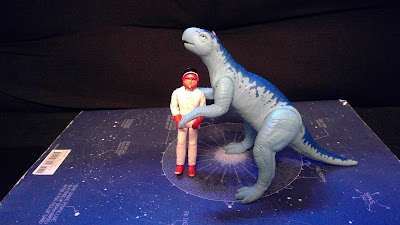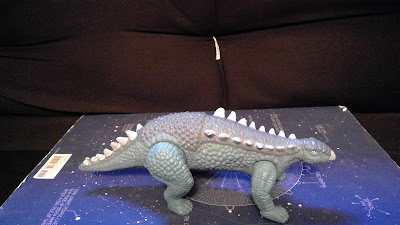As I write, it's the start of a new week and a new month, and I still haven't filled out the previous week. I realized I also hadn't done an installment of this feature since the anniversary post. I seriously debated doing a fiction post to keep this quick, but in the end, I never regret taking a break for a cool dino. It happens that there was one particular dino that's been on my mind from what I have already praised as the greatest dinosaur line of all time. Here is the Definitely Dinosaurs Psittacosaurus, with a friend.
Now for the science, Psittacosaurus mongoliensis was a small herbivorous dinosaur that lived in Mongolia and China about 120 million years ago. It is considered an early and primitive member of the ceratopsian lineage, in some lights transitional between the horned dinos and their nearest relatives, the pachycephalosaurs. It was probably 2 meters long and 20 kg in weight, comparable to a large dog. Through the time this toy was made, it was portrayed as seen here, as nondescript but aesthetically attractive dino that neatly fitted into the most linear models of evolution. Beginning in the 1980s, however, a good deal of new material was discovered including a number of new species. Naturally, things got weird. That culminated in the discovery of evidence of feathers, the first to be found outside the therepods. Before we get to that, here's another pic.
And here it is with Sidekick Carl. The scale in this line was always iffy...
It will already be obvious that this is, at the least, a conservative reconstruction. More recent reconstructions have varied on two points. The first, of course, has been the extent of its protofeather integument, and for once, the consensus has probably not gone far enough. Most will show only a few quills where the tail meets the body, the only thing directly confirmed from fossils, but on any amount of consideration, it's more likely that there was integument over most of the body than that it was otherwise absent. The other extreme is "shaggy" restorations that have so far turned up mainly in amateur paleo art (see here for a gnarly example that seems to be circulating meme-style), which are at least useful for discussion. The second and in many ways more intriguing point is whether the dino had anything close to horns. So far, most reconstructions still show it without horns on the nose or brow where they would be on a full-sized trike, which lines up with what we know from Protoceratops. What deserves more consideration is some form of frill, especially around the rear of the skull, which is consistent with what we see in the pachys. A substantiated theory which has been catching on is that they had some kind of projections on the cheeks. This just might give us a new angle on how intraspecies combat evolved: Maybe grappling or simple display with cheek horns and frills was the ancestral condition of the broader pachycephalosaur/ ceratopsian lineage (I know, Marginocephalia), but was replaced by ramming and stabbing as the diverging lines developed more specialized headgear.
And that leaves us with the friend, the Polecanthus. This is definitely one of the best of an excellent line, and it still holds up pretty well. The real thing was a relative of the ankylosaurs would have lived around the time of Psittacosaurus. It would have been about the size of a hippo, so of course, the designers managed to make it and Psittaco nearly the same size. Beyond that, there's not a lot to say. Here's an extra pic of the pair together.
And a solo pic.
And a couple closeups. Behold the awesome!!!









No comments:
Post a Comment